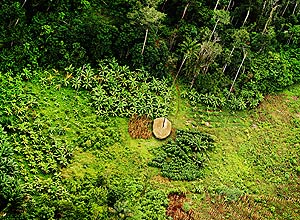[ 2009 ] Google Earth Hero: Chief Almir and the Surui tribe of Amazon
"After observing the effects of illegal logging on the Surui indigenous people's territoryin Google Earth, Chief Almir Surui began using Google Earth to protect the rainforest
and preserve his people's way of living in harmony with the rain forest".
índios suruís venderão carbono com selo verde.
09/04/2012
Uma tribo amazônica que até a década passada entregava suas terras à exploração ilegal de madeira será a primeira nação indígena do mundo a faturar com uma nova commodity: o carbono da floresta mantida em pé.
Os paiter-suruís, de Rondônia, receberam na semana passada duas certificações internacionais que lhes permitirão fechar contratos para gerar créditos de carbono pelo desmatamento que evitarem em seu território.
O projeto explora o chamado Redd (Redução de Emissões por Desmatamento), mecanismo que visa compensar financeiramente a manutenção de florestas tropicais, mitigando o gás carbônico que causa o aquecimento global.
Arquivo Idesam
|
 |
Vista aérea de roça em aldeia da Terra Indígena Sete de Setembro, em Rondônia
|
O líder da tribo, Almir Narayamoga Suruí, estima que o negócio possa gerar de R$ 2 milhões a R$ 4 milhões por ano até 2038. O dinheiro será aplicado em uma espécie de "fundo soberano" para alavancar atividades econômicas sustentáveis, como o turismo e a produção agrícola nas terras já desmatadas.
O Projeto de Carbono Florestal Suruí, fruto de quatro anos de negociação, é o primeiro esquema indígena de Redd a receber os selos VCS (Verified Carbon Standard) e CCB (Climate, Community and Biodiversity).
Segundo Mariano Cenamo, do Idesan, ONG de Manaus que elaborou o projeto, o VCS dá a garantia aos investidores de que a tribo segue uma metodologia criteriosa para avaliar a redução das emissões. O CCB atesta que o projeto não afeta a biodiversidade ou os direitos dos índios.
O mercado mundial de Redd ainda é voluntário; sua regulamentação deve ocorrer em 2020. Apesar disso, só em 2010, ele cresceu 35% e hoje é estimado em US$ 250 milhões por ano no mundo.
Segundo Michael Jenkins, diretor da ONG americana Forest Trends, os potenciais clientes dos suruís incluem empresas em busca de "créditos carismáticos" para neutralizar emissões de seu processo produtivo. Quinze países estão regulamentando mercados de carbono, e o Redd deve fazer parte deles.
A validação do projeto ocorre no momento em que o Redd em terras indígenas anda na berlinda no país.
A Funai (Fundação Nacional do Índio) e a Advocacia-Geral da União investigam 30 contratos de compra de créditos de carbono fechados por aventureiros com índios Amazônia afora. Um deles, entre a empresa irlandesa Celestial Green e os líderes mundurucus, do Pará, proíbe a tribo de usar a própria terra.
O único projeto apoiado pelo órgão federal é o dos suruís -porque a etnia resolveu esperar a validação antes de assinar contratos.
"Não faltou gente interessada", diz Almir Suruí. "Mas nunca recebemos um centavo. O projeto foi todo bancado com dinheiro de doação."
O responsável por levantar a verba foi Jenkins. Ele estima em US$ 1 milhão o custo da montagem do projeto. O dinheiro foi usado em parte para contratar o Idesam, que inventariou o carbono estocado nas florestas da terra suruí e criou um modelo computacional para simular o desmatamento que ocorreria até 2038 sem o Redd.
Outra parte bancou um escritório de advocacia para determinar se os índios tinham direito ao carbono de suas terras - têm. "Saiu caro, mas agora temos uma análise jurídica para 15% do território brasileiro", diz Jenkins, em alusão à área total das terras indígenas no país.
ScidevNet
via hathaway alencar
Indigenous Brazilian tribe certified
to trade carbon credits
13 April 2012 | EN | ES

Selling carbon credits will enable the community to fund sustainable economic activities
Arquivo Idesam
[RIO DE JANEIRO] Brazil's Paiter Suruí community has become the first indigenous group in the country to receive international certification to sell carbon credits in return for protecting and restoring forests in their Amazonian territory.
The Suruí community, which numbers around 1300 people, was first contacted by outsiders in 1968. Over the past decade, with assistance from environmental advocates, they have conducted a sophisticated campaign to prove to the world that they are helping to preserve their 248,000 hectare forest territory.
Four years ago, they established the Suruí Forest Carbon Project, with a view to selling carbon credits under the so-called REDD+ (Reducing Emissions from Deforestation and Forest Degradation) mechanism.
In late 2008, their right to trade carbon credits on the global market was legally recognised — and this week (9 April) the project was formally certified under the Verified Carbon Standard (VCS) and the Climate, Community and Biodiversity Standard (CCB).
"The VCS guarantees that the indigenous group follows a strict methodology for evaluating emission reductions," Mariano Cenamo, deputy executive secretary of the Institute for Conservation and Sustainable Development of Amazonas (IDESAM) — the non-governmental organisation (NGO) that helped the Suruí design the project — told SciDev.Net.
He added that the CCB certification will ensure that the project is carried out in a way that minimises climate change, supports sustainable development and conserves biodiversity.
According to Cenamo, the project could generate up to US$61 million for the community over the next 25 years.
"We are already negotiating with some investors," he says, adding that the funds raised could be used to boost sustainable economic activities such as tourism.
Forest Trends, an environmental NGO that introduced the Suruí to the concept of carbon credits, said this week that documents from the Carbon Project validated by VCS had revealed that the Suruí's actions have already prevented the emission of more than 200,000 tonnes of carbon dioxide from the Amazon.
Observers say the project's success is being keenly watched by other indigenous communities in Brazil.
"All the documents of the process are available for anyone interested in the issue and can help other indigenous groups to explore similar strategies," Cenamo told SciDev.Net.
"Lessons can [also] be learned from this project by the Brazilian government when designing policies for the [forest] sector."
Marcos Amend, executive director of Brazil's Conservation Strategy Fund, one of the project's partners, said: "This is a very interesting project since it is headed by indigenous people and is part of a 50-year well-organised and structured plan for managing the indigenous territory."
 #supercarrinho @supercarrinho
#supercarrinho @supercarrinho

Nenhum comentário:
Postar um comentário
super carrinho. faça as idéias rodarem aqui também.
obrigada pela participação no debate.